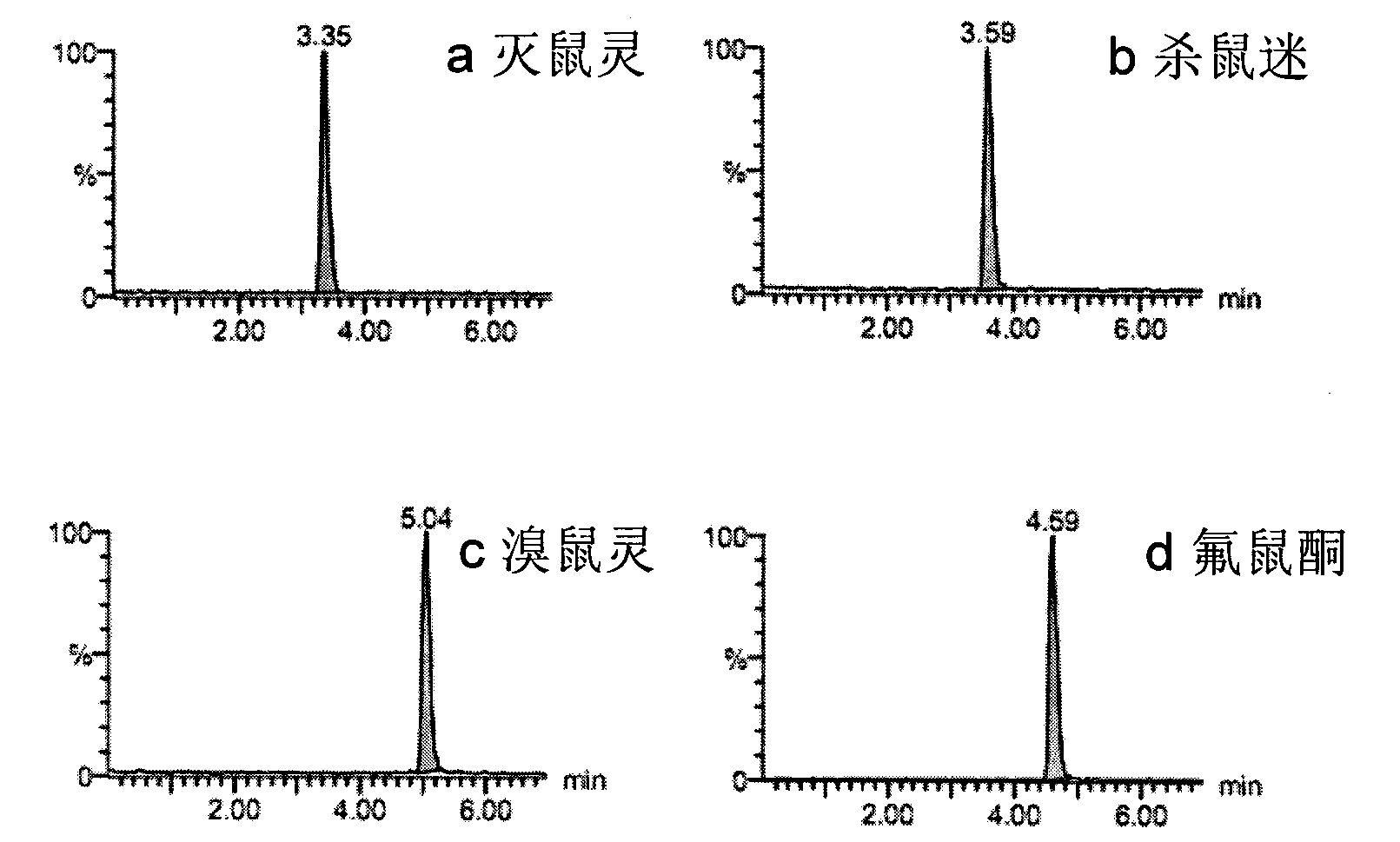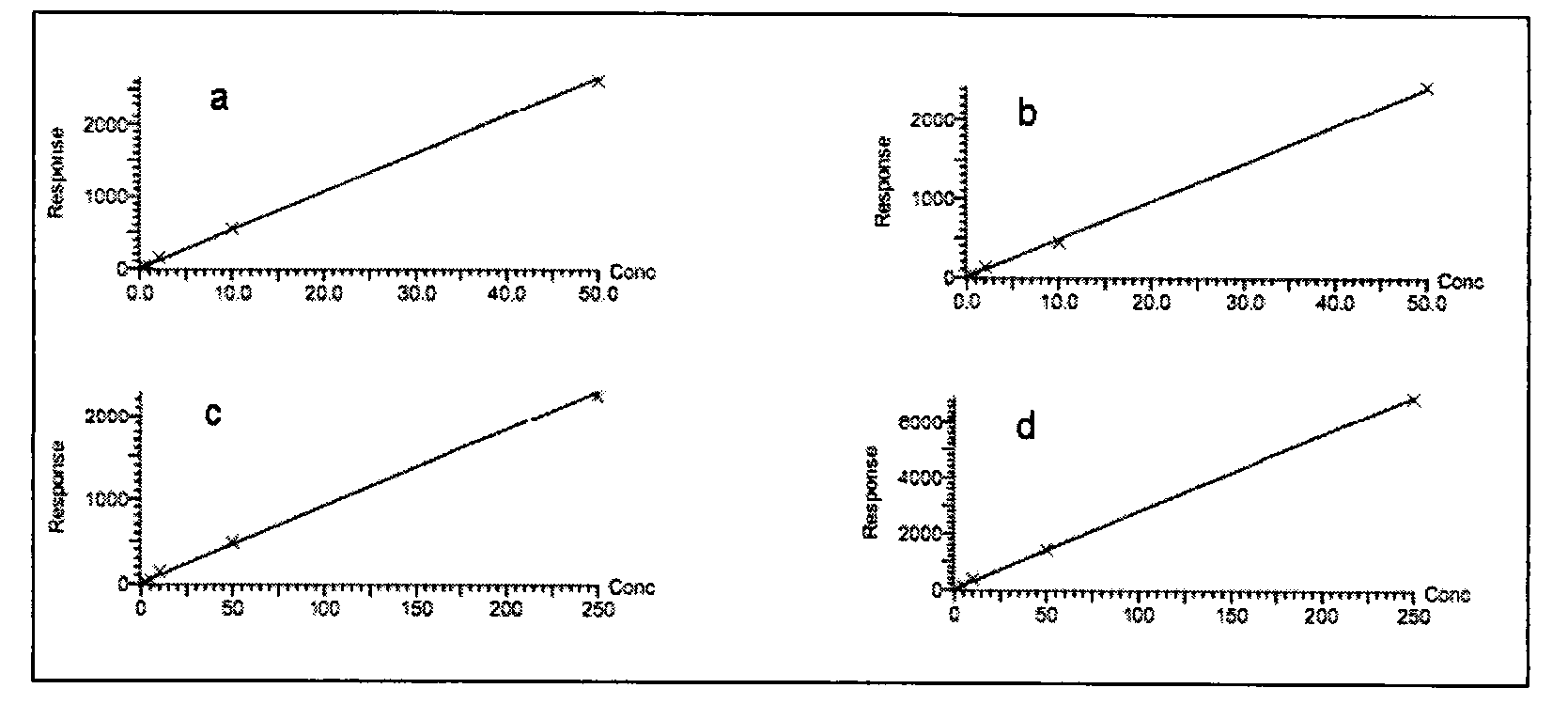Method for rapidly detecting residual quantity of 4-hydroxycoumarin rodenticide by using distributed solid phase extraction
A hydroxycoumarin, dispersed technology, applied in the direction of measuring devices, material separation, analysis of materials, etc., can solve the problems of consuming a large amount of solvents and long processing steps, and achieve the effects of solvent saving, low detection limit, and small interference
- Summary
- Abstract
- Description
- Claims
- Application Information
AI Technical Summary
Problems solved by technology
Method used
Image
Examples
Embodiment 1
[0025] Using methanol as the solvent, prepare the stock solutions of four rodenticides, mirfafeum, rodenticide, brodifafeum, and flumarumone, respectively, according to Table 1, and prepare mixed standard solutions, and perform UPLC-MS / MS based on the above experimental conditions. MS analysis detection. figure 1 It is the extracted ion chromatogram of the four detected rodenticides, the ordinate in the chromatogram represents the relative instrument corresponding value of the peak, and the abscissa is the retention time, in minutes. Depend on figure 1 It can be seen that the peak times of the four rodenticides are 3.35, 3.59, 5.04, and 4.59 minutes respectively, and they can be separated well. Make a graph with the peak area against the concentration to establish a standard curve for the four rodenticides, such as figure 2 As shown, the abscissa in the standard curve is the concentration of the target substance, and the ordinate is the response value of the liquid chromato...
Embodiment 2
[0032]Accurately weigh 10g of cucumber sample into a 50ml plastic centrifuge tube, add an appropriate amount of acetonitrile, add an appropriate amount of glacial acetic acid to acidify, add an appropriate amount of filler anhydrous sodium acetate, anhydrous magnesium sulfate, etc. to a 50ml centrifuge tube, and vortex first to mix 1min, then placed in the ultrasonic instrument, ultrasonic at room temperature for 5 minutes. Then, it was refrigerated and centrifuged at 4000 g for 5 min at 4 °C. Take the supernatant and transfer it into a 2ml small centrifuge tube, add an appropriate amount of purification filler anhydrous magnesium sulfate and amino adsorbent, refrigerate and centrifuge at a speed above 6000g for 5 minutes, take the supernatant, pass it through the membrane, and run it on the machine for liquid chromatography-tandem mass spectrometry detection . Two parallel samples were made for this sample, and the target substance was not detected in the sample. The stabil...
Embodiment 3
[0036] The standard solution in Example 1 was added to the vegetables in Example 2, and the experiment was carried out according to the pretreatment method and instrumental analysis and detection method of the above-mentioned samples. Three concentration spike experiments were done on this sample, and the samples of each spiked concentration were measured in parallel three times, and the average value of the three measurements was taken. According to the amount of reagent added and the actual measurement results, the recovery rate of the sample was calculated. The experimental results are shown in Table 4. It can be seen from Table 4 that the recovery rate of the samples is between 96-129%.
[0037] Table 4 The recovery of standard addition of this sample
[0038]
PUM
 Login to View More
Login to View More Abstract
Description
Claims
Application Information
 Login to View More
Login to View More - R&D
- Intellectual Property
- Life Sciences
- Materials
- Tech Scout
- Unparalleled Data Quality
- Higher Quality Content
- 60% Fewer Hallucinations
Browse by: Latest US Patents, China's latest patents, Technical Efficacy Thesaurus, Application Domain, Technology Topic, Popular Technical Reports.
© 2025 PatSnap. All rights reserved.Legal|Privacy policy|Modern Slavery Act Transparency Statement|Sitemap|About US| Contact US: help@patsnap.com



